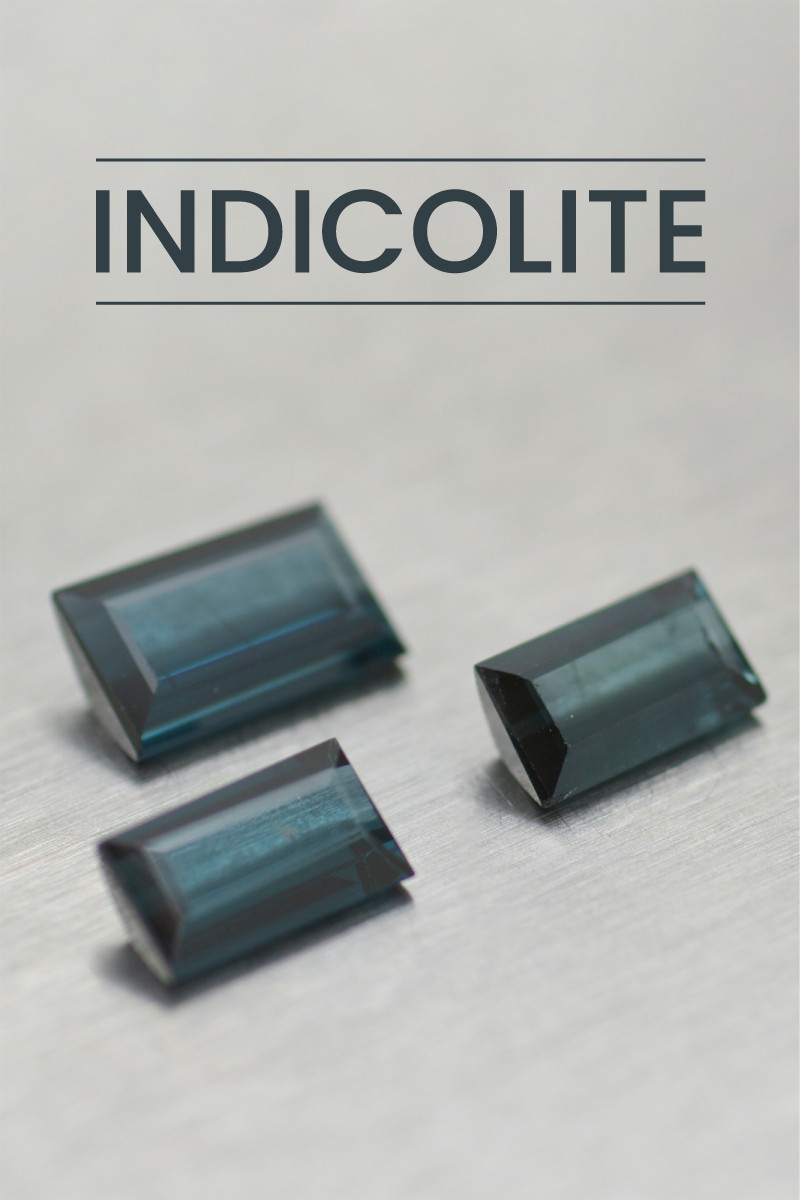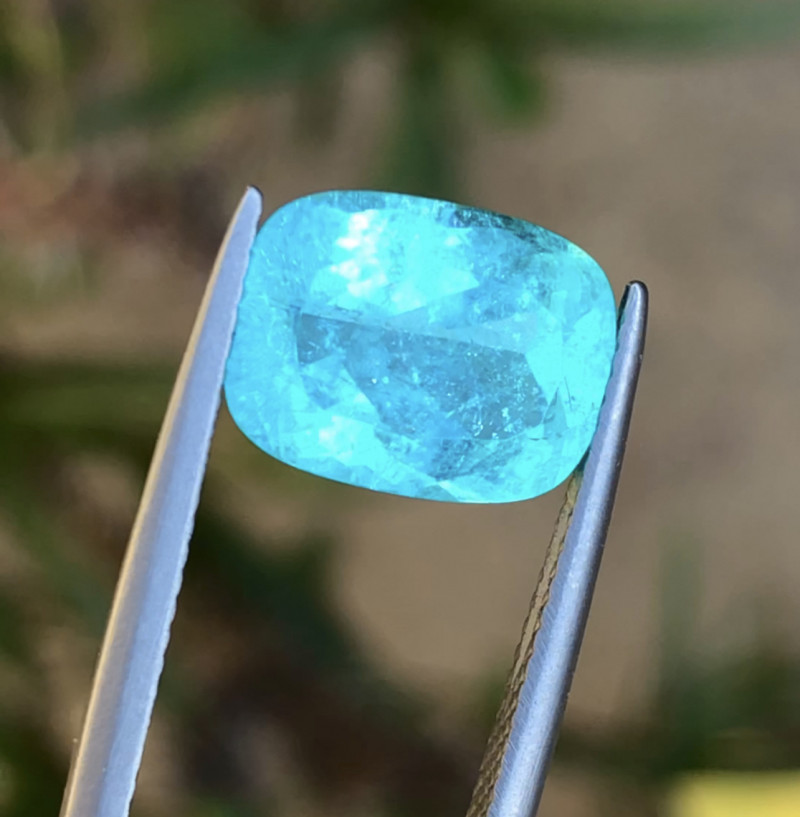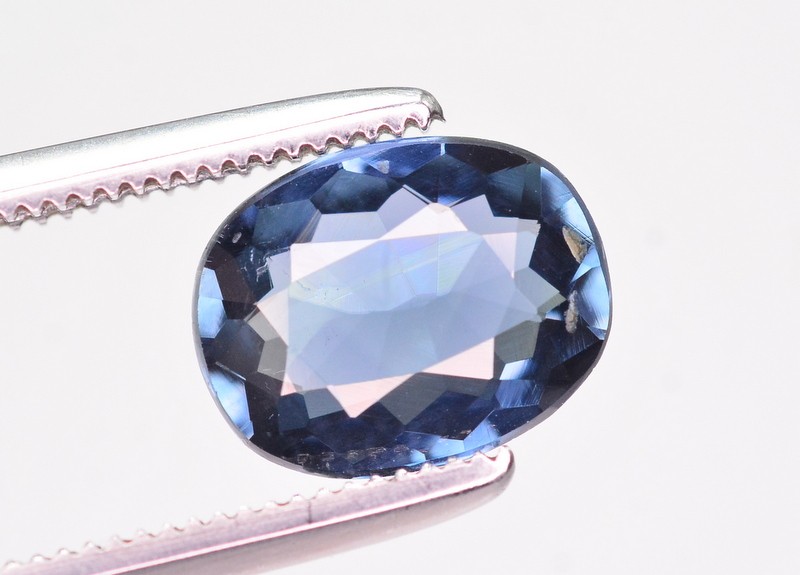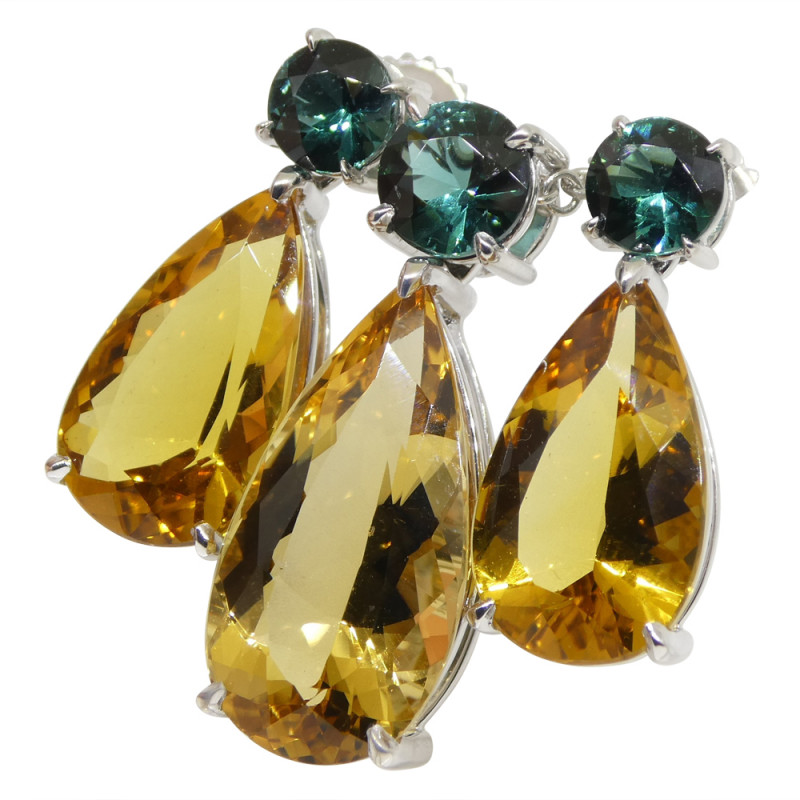
インディコライト宝石:特性、意味、価値など
 インディコライト(発音:インダコライト)は、複雑なトルマリン系の宝石に属する鉱物です。では、インディコライト自体が宝石なのでしょうか?はい!インディコライトは様々な形やジュエリーの宝石として発見されています。
インディコライト(発音:インダコライト)は、複雑なトルマリン系の宝石に属する鉱物です。では、インディコライト自体が宝石なのでしょうか?はい!インディコライトは様々な形やジュエリーの宝石として発見されています。
トルマリンの仲間は複雑で多岐にわたります。中には、黒トルマリンを含む茶色から黒色のショールシリーズのように、特定の色を持つことで知られるものもあります。
インディコライトの色は何ですか?このトルマリンの色は青の色合いで、時には緑の色合いを持つこともあります。
では、ブルートルマリンとインディコライトは同じものなのでしょうか?一般的にはそうです。インディコライトは「ブルートルマリン」と呼ばれることが多いです。
トルマリンは最も色鮮やかな鉱物ですが、インディコライトは珍しい色なのでしょうか?はい、実はトルマリンの中で最も珍しい色は青色です。
販売中のインディコライトトルマリンを閲覧する前に、インディコライトについて詳しく調べる準備はできていますか?インディコライト宝石の特性、価格、意味、グレードについてご説明します。

インディコライト石について
インディコライトトルマリンは半貴石ですが、ブラジル産のインディコライトは、その外観が貴石に似ていることから「ブラジリアンサファイア」として販売されることがあります。しかし、サファイアは別の石であり、トルマリンをサファイアとして表示することはFTC(連邦取引委員会)のガイドラインに違反します。
そうは言っても、インディコライトはサファイアに似ているため、伝統的な9 月の誕生石や結婚 40 周年記念の宝石よりも手頃な代替品となります。
トルマリンの一種であるインディコライトは、伝統的な10月の誕生石、結婚8周年の記念石、そして天秤座の星座石として知られています。また、水星と冥王星のスターストーンであるだけでなく、牡牛座、獅子座、蠍座にも効果があります。
さらに、トルマリンはアメリカ合衆国メイン州の州指定鉱物です。この石は「インディゴライト」や「アクアライト」とも呼ばれています。
コテージコアやダークアカデミアといった美学をご存知ですか?「インディコライト」もクリスタルにちなんで名付けられたもので、ヴィンテージブルー、輝き、そして水の要素を融合させたエレガントな美学です。
要素といえば、インディコライトの組成に含まれる要素と石の鉱物特性について見ていきましょう。

インディコライトの仕様と特徴
トルマリンの仲間は複雑で、ガーネットと同様に、いくつかの包括的な系列の下に様々な変種が存在します。インディコライトの化学式も複雑で、Na(Li,Al)1.5Al6(Si6O18)(BO3)3(OH)3(OH)と続きます。
インディコライトは、エルバイトトルマリン系列(または種)に属する複合ホウケイ酸塩です。エルバイトは最も一般的な宝石質の系列で、アルミニウム、ナトリウム、リチウムを含みます。インディコライト以外にも、エルバイトの宝石として人気のあるものとしては、ヴェルデライト、ウォーターメロントルマリン、そしてルベライトなどがあります。
その他の重要なトルマリン系列はショールとドラバイトです。
通常、インディコライトの結晶は柱状です。トルマリンの結晶は、長面に沿って垂直に走る明瞭な条線(表面の長い溝)を持つことで知られています。また、インディコライトのようなトルマリンは、長面に沿って、あるいは断面を通して、しばしばカラーゾーニング(色帯)を示します。
トルマリンは、時には 3 面柱状になったり、結晶の先端と底部が異なる形状になる半形結晶になったりする点でも独特です。
以下は残りのインディコライト鉱物の特性です。
モース硬度:7~7.5
色: 青、緑がかった青、青緑の色合い
結晶構造:三方晶
光沢:ガラス質
透明性:透明から不透明
屈折率:1.62~1.64
密度:2.90~3.10
分裂:[1120]と[1011]では不明瞭
骨折:貝殻状
縞模様:白
発光: 蛍光は時々存在するが弱い - SW-UV および LW-UV では青緑色
多色性:濃い青から薄い青にかけて強く現れる
複屈折:0.014~0.022
分散:0.017(中程度)
光学効果: シャトヤンシーの可能性
 上の写真:パライバトルマリン
上の写真:パライバトルマリン
インディコライト vs. パライバトルマリン
上記で触れなかったエルバイトシリーズのもう一つの石は、パライバトルマリン、または「銅エルバイト」です。パライバトルマリンは、鮮やかなネオンブルー、青緑、または紫色のトルマリンで、1980年代にブラジルのパライバ州で発見されたことからその名が付けられました。
産地名に由来するパライバですが、厳密には銅の含有量で定義されます。そのため、ブラジル以外の地域でもパライバトルマリンが発見・採掘されるようになりました。最も価値の高いパライバトルマリンは、鮮やかなブルーまたはバイオレットの色合いをしています。
インディコライトとパライバトルマリンの違いは何ですか?
例えば、パライバはより鮮やかで彩度の高い色彩で知られ、青や緑だけでなく紫の色合いも持ち合わせています。パライバの色は銅(紫の色合いにはマンガンが添加されています)に由来し、インディコライトの色は鉄に由来します。
二つ目は希少性です。ブルートルマリンはどれも希少ですが、パライバトルマリンは最も希少なトルマリンです。これは価格にも反映されており、高級品は同サイズの高級インディコライトの6倍の価格になることもあります。
この重要な違いが明らかになったので、次はインディコライトの時代を超えた象徴性について詳しく見ていきましょう。

インディコライトの意味と歴史
インディコライトはインスピレーション、心の広さ、共感を象徴します。
歴史を通して、トルマリンには様々な伝説が語り継がれてきました。古代エジプトの伝説によると、トルマリンの虹色の輝きは、トルマリンが地球の中心から虹に沿って移動し、そのスペクトルを吸収したためだと言われています。
近代以降、インディコライトは様々なグループによって幸運のお守りとして用いられてきました。また、創造力を高めるとも信じられており、クリエイティブな分野で活躍する人々の間で人気があります。
ブラジルの鉱物学者ホセ・ボニファシオ・デ・アンドラダ・エ・シルバは、1800年にラテン語の「藍」を意味する「インディクム」にちなんでインディコライトと名付けました。これは、1913年にロシアの鉱物学者ウラジミール・イワノビッチ・ヴェルダツキーがイタリア沖のエルバ島にちなんでエルバイト系列にその名を与えるずっと前のことでした。
トルマリンは長きにわたり愛されてきたため、インディコライトが正式に発見された時期は不明です。実際、トルマリンは他の宝石と間違えられることがよくあるため、インディコライトも他の石と間違えられていた可能性があります。
いずれにせよ、インディコライトは現在、ジュエリー、装飾品、そしてもちろんクリスタルヒーリングに使用されています。

インディコライトの治癒特性
他の宝石と同様に、インディコライトはヒーリングストーンとして作用します。インディコライトブルートルマリンは、他の青い宝石と同様に、平穏、共感、誠実さを育みます。緑色の色合いは、幸運、バランス、そして 緑の宝石に特有のポジティブさをもたらします。
インディコライトの身体的、感情的、チャクラの治癒力についてはどうですか?
身体の治癒
身体的には、インディコライトは次のような症状を治療すると考えられています。
バーンズ
頭痛
不眠症
めまい
傷跡
感染症
感情的な癒し
感情面では、インディコライトは忍耐力と寛容さを高めてくれます。トラウマからの回復を促し、過去ではなく未来を見据えた受容的な見通しを持つことができると言われています。また、心を解放し、自己疑念から解放されて自分の可能性を探求できるようになると信じられています。
チャクラヒーリング
チャクラヒーリングは、身体にある 1 つ以上のエネルギー センター (チャクラ) を開いて、チャクラがブロックされたりバランスが崩れたりすることで生じる悪影響を解消する古代のプロセスです。
インディコライトは喉のチャクラの石であり、真実、理解、そしてコミュニケーションのエネルギーセンターです。インディコライトがチャクラを開くと、真の自分をより深く理解し、表現するよう促します。
もちろん、ヒーリングを始めるにはインディコライトを購入する必要がありますよね? 最高の価格で手に入れるためには、どのような特性に注目すべきかを知ることが重要です。

インディコライト宝石の特性
トルマリンの等級付けは複雑で、多少主観的であり、需要によって変わることもありますが、インディコライトの価値の一般的な分類は、色、カット、透明度、カラット重量、処理です。
色
ほとんどのインディコライトは緑色の基調を持つため、純粋なブルーのインディコライトが最も価値があります。彩度はグレーがかったものから鮮やかなものまで様々です。彩度の高い色合いが理想的ですが、多色性、輝き、そして透明感を感じられる程度に明るい色であることも重要です。
そのため、濃い色の石や緑色がかった石の多くは、色の価値を高めるために処理されています。
カット
インディコライトのファセットカットは、多色性と分散性(多彩な輝き)を最大限に引き出すために、カット職人が石の向きを適切に調整する必要があるため、時に困難を極めます。特に濃い色の標本の場合、これは困難を極めます。
淡い色の標本は、事実上あらゆるファセットカットが可能です。エメラルドカット、オーバルカット、クッションカット、ファンシーカットが一般的です。ラウンドブリリアントカットやチェッカーボードカットは、彩度が高く、大きな宝石に最適です。
シャトヤント効果のあるインディコライトは、その「キャッツアイ」を美しく見せるためにカボションカットにする必要があります。そうでない場合、低品質のインディコライトは彫刻、タンブル加工、または原石のままにされることがあります。
明瞭さ
インディコライトは、 カラーストーンのクラリティグレードがタイプIIです。これは、高品質の石には通常、肉眼で目に見える内包物がないことを意味しますが、他の標本には通常、多少の内包物があります。トルマリンの色は様々ですが、一般的に青と緑の石のクラリティは優れています。
インディコライトに含まれる可能性のある内包物や不純物には次のようなものがあります。
カラーゾーニング
細長い液体およびガスの包有物
ガスで満たされた反射亀裂
内包物の多くは価値を下げますが、針状結晶(多くの場合ルチル)の繊維状の束がシャトヤンシー効果をもたらすことで、かなり価値の高い「キャッツアイトルマリン」インディコライトが生まれることがあります。キャッツアイトルマリンの価値は、反射された「キャッツアイ」の鮮明さ、そして石の色、サイズ、透明度によって決まります。
カラット重量とサイズ
インディコライトは幅広いカラット重量で販売されていますが、カラットあたりの価格はカテゴリー分けされています。0.4カラットから2カラットまでは単一の価格帯ですが、2カラットから10カラット以上の宝石は価格帯が高くなります。カボションは一般的に2カラット以上です。
全体的に、インディコライトの宝石は、実質的にあらゆる予算に合わせたサイズが揃っています。
トリートメント、合成品、模擬薬
現在市場で入手可能なブルートルマリンの大部分は、加熱や放射線照射処理が施されており、「ブルーアイス」のような呼び名が付けられていることが多いです。
インディコライトは加熱と放射線照射によって色が薄くなり、透明度と輝きが向上します。パライバトルマリンは加熱によってネオンカラーに見えることが多く、これらの新しい色はトルマリンの中で安定しています。
耐久性に関わるその他の処理としては、宝石の透明度を高め、欠陥を隠すためのフラクチャーフィリング(樹脂やオイルで行われることが多い)があります。これは、内包物の多い石によく見られます。
すべての販売者が処理方法を開示しているわけではありませんが、注目すべき点がいくつかあります。複数のインディコライトがあり、すべて同じように見える場合は、処理されている可能性が高いです。未処理の宝石はそれぞれ微妙に異なります。また、直射日光の下で石を回転させると色が変化する場合、通常は未処理のインディコライトです。
合成トルマリンは宝飾品市場では一般的ではありませんが、様々な石に染色などの処理を施し、類似品として販売されることがあります。例としては、ベルデライト(トルマリンの一種)、スピネル、クォーツなどが挙げられます。

インディコライトの形成と産地
トルマリンは地下で生成されます。マグマが地下水を熱し、鉱物を溶解させます。水は溶解した鉱物を岩の割れ目に運び、蒸発することで結晶が形成されます。
生成中に微量元素の種類や量が変化すると、カラーゾーニングが発生する可能性があります。
インディコライトのようなエルバイトトルマリンは、花崗岩ペグマタイトや片岩などの変成岩や火成岩、また熱水鉱床中に形成されます。
採掘場所
インディコライトトルマリンはどこから産出されるのでしょうか?インディコライトは多くの産地で産出されますが、宝石として最も優れた素材はブラジルとスリランカ産です。
宝石品質のインディコライトの追加の供給源は次のとおりです。
アフガニスタン
マダガスカル
メキシコ
モザンビーク
ナミビア
ナイジェリア
パキスタン
ロシア
アメリカ合衆国(カリフォルニア州およびメイン州)
 上の写真:インディコライトとヘリオドールの宝石ジュエリー
上の写真:インディコライトとヘリオドールの宝石ジュエリー
インディコライト石の価格と価値
最も価値の高いインディコライトは、純粋な青色、肉眼でわかるほどの透明度、光学特性がよくわかる優れたカットを備えており、(通常は)何の処理も施されていません。
0.4 ~ 2 カラットのファセットカットされたインディコライトの 1 カラットあたりの価格は、50 ~ 500 ドルの範囲です (最高品質のパライバトルマリン宝石の 1 カラットあたりの価格が 30,000 ドルであることとは対照的です)。
2カラット以上のファセットカットの宝石は、1カラットあたり50ドルから1,000ドルで取引されます。通常のインディコライトのカボションは1カラットあたり100ドルから150ドル、キャッツアイのカボションは1カラットあたり30ドルから200ドルです。
インディコライト原石の卸売価格は 1 カラットあたり 4 ドルから 20 ドルです。
インディコライトのケアとメンテナンス
幸いなことに、インディコライトの宝石のお手入れは非常に簡単です。どんなジュエリーでも、普段使いにぴったりです。インディコライトのリングやブレスレットなど、繊細な宝石でも問題ありません。
特別なケアが必要なのは、処理済みの石のみです。骨折した石は、機械式洗浄機(超音波洗浄機やスチームクリーナーなど)や刺激の強い化学薬品から遠ざけてください。
インディコライトは、ぬるま湯、中性洗剤、柔らかい歯ブラシで洗います。よくすすいだ後、柔らかいマイクロファイバーの布で乾かしてください。
トルマリンは極度の熱や急激な温度変化に弱いため、インディコライトは直射日光や他の宝石を避け、比較的涼しい場所に保管してください。

インディコライトにインスピレーションを受けたのですか?
青が好きな方、トルマリンが好きな方、あるいはただ海のように輝く宝石をお探しの方、インディコライトはまさに理想的な選択肢です。どんな個性にも合う色合いと鮮やかさがあり、価格帯も幅広いので、ほぼあらゆる予算に対応できます。
Gemstone Encyclopedia検索
最新記事
Chiolite is a rare, colorless to white mineral related to cryolite. Gems are very rare, only from a couple sources. Discover the uses, history, prices, and traits of chiolite here.
5th Dec 2025
ブライトハウプタイトは、ニッケル鉱に関連する銅赤色から紫色のアンチモン鉱物で、金属光沢と銀鉱石との関連性で知られています。ブライトハウプタイトの歴史、特徴、価値、そして用途について学びましょう!
21st Nov 2025
ウィルケイトは、カリフォルニアで発見され、美しい青、ピンク、紫の色合いで知られるアパタイトグループの鉱物です。このガイドでは、ウィルケイトの歴史、特徴、価格、用途についてご紹介します。
17th Nov 2025
記事のカテゴリ
How To's is where you will find helpful articles from gem Rock Auctions on how to cut gemstones, select gemstones and buy gemstones.
9記事数




